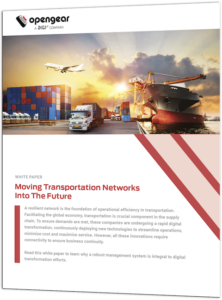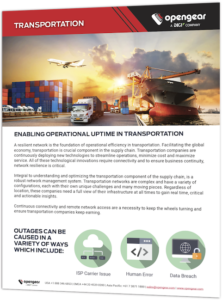Transportation organizations are key components in the supply chain, facilitating the global economy by ensuring goods and people get to their appropriate destinations on time. This new digital age has brought with it an increased demand for services beyond a person or businesses immediate vicinity. This has caused companies within the transportation industry to continuously deploy new technologies to keep up.
The airline industry has specifically begun investing in digital initiatives to open new revenue streams, increase productivity and improve customer satisfaction. According to a recent study, the airline digitalization market is expected to reach approximately $35 billion by 2030.[1] Many have already committed to migrating to the cloud within the next decade. However, most airlines are grappling with infrastructure that fails to meet modern requirements and those needed for transformational efforts. These complex ecosystems require a resilient network to facilitate all of their applications.
The air cargo airline industry has lacked effective integration digitally. Preventing stakeholders from efficient collaboration, this has created a reliance on manual processes resulting with little visibility for customers.
Benefits Of Digitalization
As passenger revenue decreased due to travel restrictions, cargos greatly increased. Air cargo is now making considerable contributions to airlines bottom lines, with some trade routes between individual regions seeing freight rates increase by 100%. As demand continuously grows, the industry is optimizing operations by deploying new technologies.
For example, most cargo airlines have relied on long term contracts and bulk allocation models for sales. This is a high friction process, but spot bookings are now on the rise, making up almost 90% of individual reservations for airlines. This has made it crucial that airlines have the capability to price dynamically using digital platforms. Allowing e-sales alone is expected to ensure optimal returns of an estimated 12% in the first year[2].
To achieve an air cargo supply chain that’s fully, digitally connected, airlines and international trade organizations are collaborating to deploy new technologies. These innovations are helping to address challenges by:
- Increasing data sharing to provide full visibility on shipments to stakeholders
- Improving data availability
- Creating more customer-centric services to provide
A preferred method of transportation because its security during cargo moves and fast transit times, the industry is already underway, deploying new initiatives for supply chain visibility. Some of these include:
- One Record: A common data model that is shared through standardized and secured web API. It enables shipments to be viewed through single records.
- Interactive Cargo: Creating responsive air cargo services, airlines are using systems to self-monitor, send real-time alerts and report on the cargos location. This all enables data driven improvements.
- Cargo Connect: Creating a stronger connection between distributors, freight forwarders and airlines, this system simplifies communications with Cargo Community Systems (CCS). Customers and airlines can increases collaboration through improved visibility.
All these initiatives require a connected network. Having secure, always-on access to infrastructure is a necessity to ensure effective communications and operations with all of these platforms.
Smart Solutions To Network Resilience
Dealing with distributed networks, harsh environmental conditions and a continual flow of data, airlines need always-on access to simplify network management. Enabling secure, remote management, these organizations have the ability to ensure business continuity, even during a disruption.
Airlines demand complete confidence in the networks that power their projects. Specifically, regarding security, compliance and performance, engineers rely on a multitude of applications, including Transportation Management Systems (TMS). They are constantly adding new ones to the network. These systems create a standardized process, allowing operators to manage all transportation activities across the entire organization and supply chain. However, without an independent management plane, any type of network outage will deny access to a TMS and completely disrupt overall operations.
A Smart Out-of-Band network allows airlines to separate and containerize functions outside of the management plane. Operating free from the primary in band network, when combined with Failover to Cellular™, these businesses have always on availability to maintain visibility of their entire network, even during an outage. Engineers will ensure business continuity at all times with the capability to access and manage remote infrastructure. They will have the critical ability to remotely identify and remediate network issues, without interrupting operations.
[1] https://www.frost.com/news/press-releases/global-airline-digitalization-gains-traction-thanks-to-digital-technologies-and-data-analytics/
[2] https://aviationweek.com/air-transport/how-e-commerce-fueling-air-cargo-growth






